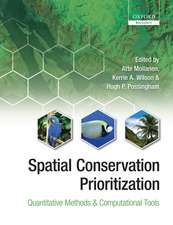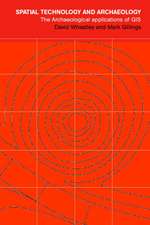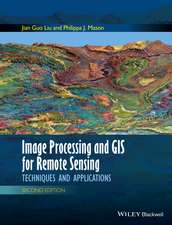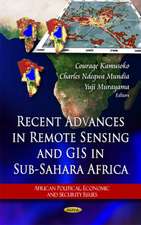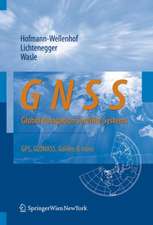Earth Science Satellite Applications: Current and Future Prospects: Springer Remote Sensing/Photogrammetry
Editat de Faisal Hossainen Limba Engleză Paperback – 30 mai 2018
| Toate formatele și edițiile | Preț | Express |
|---|---|---|
| Paperback (1) | 944.36 lei 6-8 săpt. | |
| Springer International Publishing – 30 mai 2018 | 944.36 lei 6-8 săpt. | |
| Hardback (1) | 950.52 lei 6-8 săpt. | |
| Springer International Publishing – 30 mai 2016 | 950.52 lei 6-8 săpt. |
Din seria Springer Remote Sensing/Photogrammetry
- 15%
 Preț: 653.98 lei
Preț: 653.98 lei - 24%
 Preț: 847.79 lei
Preț: 847.79 lei - 24%
 Preț: 911.57 lei
Preț: 911.57 lei - 15%
 Preț: 644.18 lei
Preț: 644.18 lei - 24%
 Preț: 694.69 lei
Preț: 694.69 lei - 18%
 Preț: 785.11 lei
Preț: 785.11 lei - 18%
 Preț: 950.52 lei
Preț: 950.52 lei - 18%
 Preț: 895.58 lei
Preț: 895.58 lei - 18%
 Preț: 1112.60 lei
Preț: 1112.60 lei - 18%
 Preț: 946.87 lei
Preț: 946.87 lei - 18%
 Preț: 1244.71 lei
Preț: 1244.71 lei - 18%
 Preț: 1114.02 lei
Preț: 1114.02 lei - 24%
 Preț: 728.31 lei
Preț: 728.31 lei - 24%
 Preț: 895.53 lei
Preț: 895.53 lei - 18%
 Preț: 1105.83 lei
Preț: 1105.83 lei - 20%
 Preț: 560.06 lei
Preț: 560.06 lei - 18%
 Preț: 1043.14 lei
Preț: 1043.14 lei - 18%
 Preț: 944.34 lei
Preț: 944.34 lei - 18%
 Preț: 888.18 lei
Preț: 888.18 lei - 18%
 Preț: 892.46 lei
Preț: 892.46 lei - 18%
 Preț: 1005.61 lei
Preț: 1005.61 lei - 24%
 Preț: 844.07 lei
Preț: 844.07 lei
Preț: 944.36 lei
Preț vechi: 1151.66 lei
-18% Nou
Puncte Express: 1417
Preț estimativ în valută:
180.76€ • 196.41$ • 151.94£
180.76€ • 196.41$ • 151.94£
Carte tipărită la comandă
Livrare economică 21 aprilie-05 mai
Preluare comenzi: 021 569.72.76
Specificații
ISBN-13: 9783319815114
ISBN-10: 3319815113
Ilustrații: VIII, 284 p. 72 illus. in color.
Dimensiuni: 155 x 235 mm
Greutate: 0.41 kg
Ediția:Softcover reprint of the original 1st ed. 2016
Editura: Springer International Publishing
Colecția Springer
Seria Springer Remote Sensing/Photogrammetry
Locul publicării:Cham, Switzerland
ISBN-10: 3319815113
Ilustrații: VIII, 284 p. 72 illus. in color.
Dimensiuni: 155 x 235 mm
Greutate: 0.41 kg
Ediția:Softcover reprint of the original 1st ed. 2016
Editura: Springer International Publishing
Colecția Springer
Seria Springer Remote Sensing/Photogrammetry
Locul publicării:Cham, Switzerland
Cuprins
Introduction: Many Eyes in the Sky and Compound Eye.- Overview of current and future satellite missions for societal applications.- How is more eyes better than one eye?.- Theme: Water and Disaster Management.- Africa.- Asia.- South America.- Europe.- Issues and the Path Forward.- Theme: Agricultural Management.- Africa.- Asia.- South America.- Europe.- Issues and the Path Forward.- Theme: Energy and Carbon Management.- Africa.- Asia.- South America.- Europe.- Issues and the Path Forward.- Theme: Health and Eco-logical Forecasting.- Africa.- Asia.- South America.- Europe.- Issues and the Path Forward.- CLOSURE Chapter.
Notă biografică
Faisal Hossain received his Ph.D. from The University of Connecticut in 2004, his M.S (1999) and B.S (1996) from The National University of Singapore and Indian Institute of Technology, Varanasi, respectively. His research interests comprise hydrologic remote sensing, sustainable water resources engineering, transboundary water resources management and engineering education. He is the recipient of awards such as NASA New Investigator Award (2008), American Society of Engineering Education (ASEE) Outstanding Research Award (2009), US Fulbright Faculty Award (2012), G.O.L.D. (Graduate Of the Last Decade) award from University of Connecticut (2012), American GeophysicalUnion (AGU) Charles Falkenberg Award (2012), American Meteorological Society Editor's Award (2015) and ASCE Walter Huber Award (2015).
Faisal Hossain has published over 100 peer-reviewed journal articles, authored an undergraduate textbook, edited three book volumes and contributed nine book chapters. His group's research work on human modification of extreme events by artificial reservoirs has been featured by media such as the BBC, National Geographic and New Scientist. His capacity building initiative promoting satellite remote sensing has resulted in an independently-owned satellite management system for the Government of Bangladesh (using altimetry) and Pakistan (using gravimetry) that is now planned for expansion to other nations. Currently he serves as Editor for Journal of Hydrometeorology, chair for ASCE Task Committee on "Water Infrastructure, Weather and Climate" and Applications lead for Science Team of Surface Water Ocean Topography (SWOT) Mission.
Faisal Hossain has published over 100 peer-reviewed journal articles, authored an undergraduate textbook, edited three book volumes and contributed nine book chapters. His group's research work on human modification of extreme events by artificial reservoirs has been featured by media such as the BBC, National Geographic and New Scientist. His capacity building initiative promoting satellite remote sensing has resulted in an independently-owned satellite management system for the Government of Bangladesh (using altimetry) and Pakistan (using gravimetry) that is now planned for expansion to other nations. Currently he serves as Editor for Journal of Hydrometeorology, chair for ASCE Task Committee on "Water Infrastructure, Weather and Climate" and Applications lead for Science Team of Surface Water Ocean Topography (SWOT) Mission.
Textul de pe ultima copertă
The combined observational power of the multiple earth observing satellites is currently not being harnessed holistically to produce more durable societal benefits. We are not able to take complete advantage of the prolific amount of scientific output and remote sensing data that are emerging rapidly from satellite missions and convert them quickly into decision-making products for users. The current application framework we have appears to be an analog one lacking the absorption bandwidth required to handle scientific research and the voluminous (petabyte-scale) satellite data. This book will tackle this question: "How do we change this course and take full advantage of satellite observational capability for a more sustainable, happier and safer future in the coming decades?"
Caracteristici
Questions the type of value-added products/information we should provide for resource constrained public and national stakeholder agencies Looks at the optimal business model for society to benefit sustainably from scientific research and satellite observational data to support the operational (recurring) costs Leverages the combined observational power of NASA earth observing satellite missions (current and future) in a synergistic manner to rapidly multiply societal applications Includes supplementary material: sn.pub/extras

